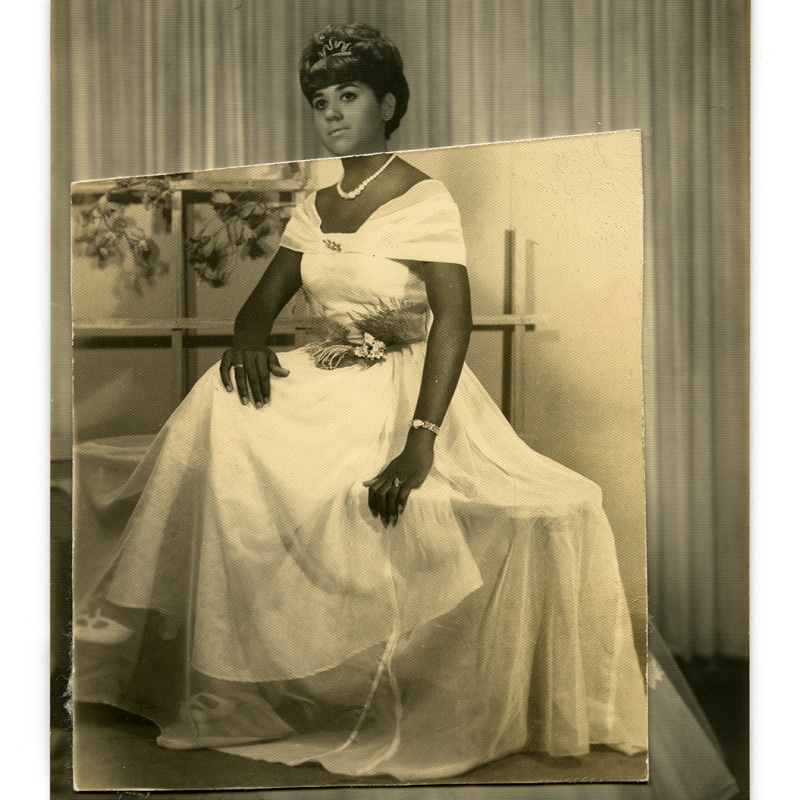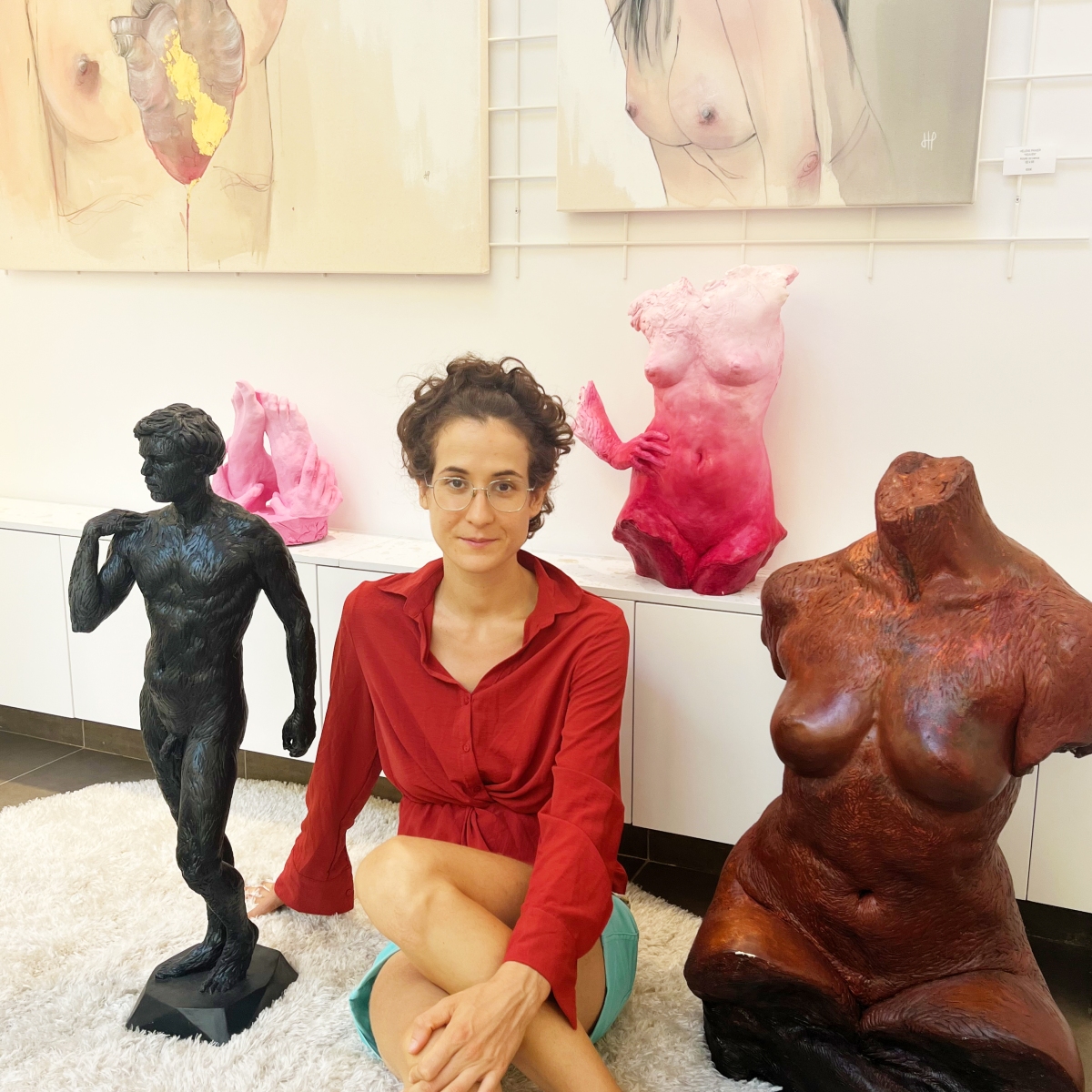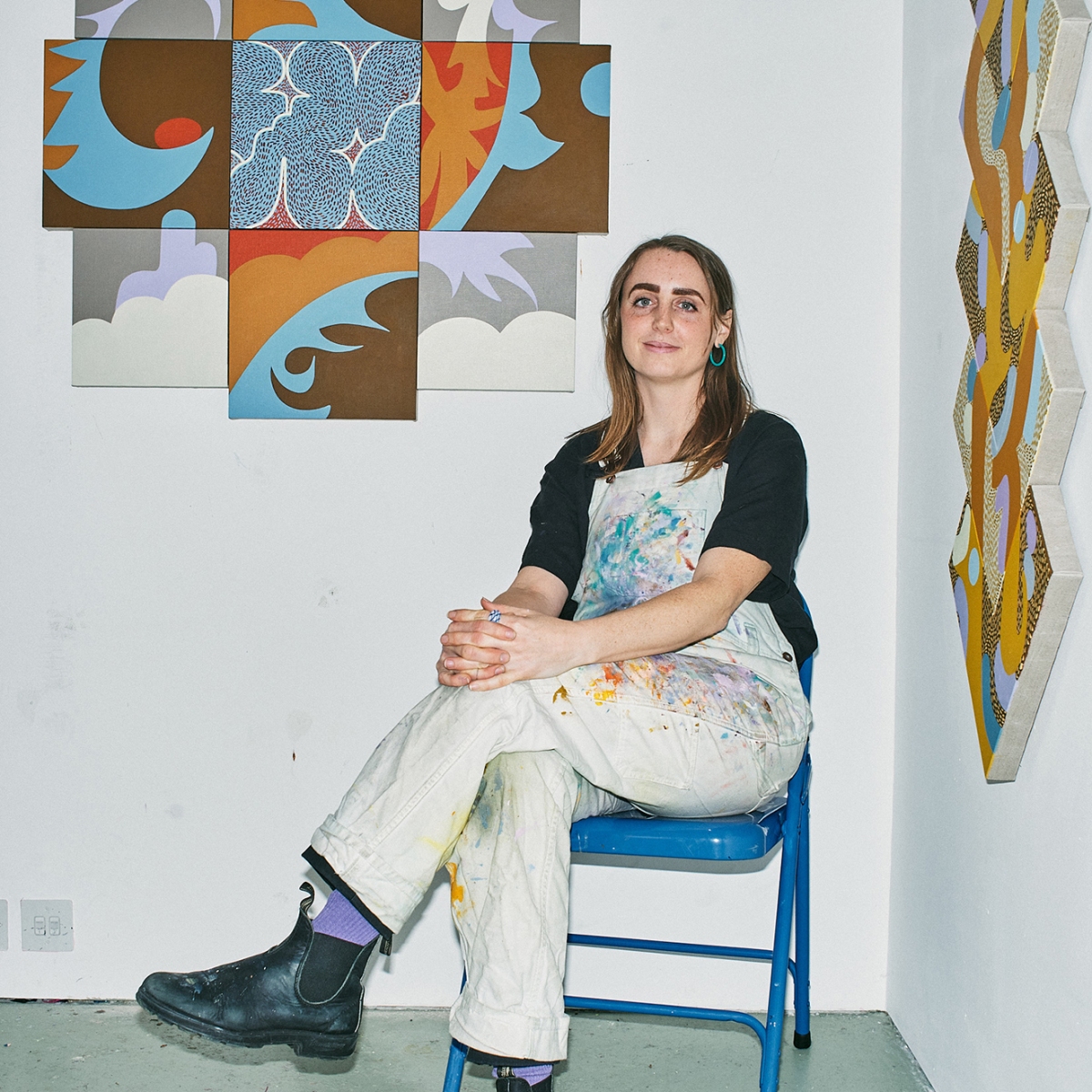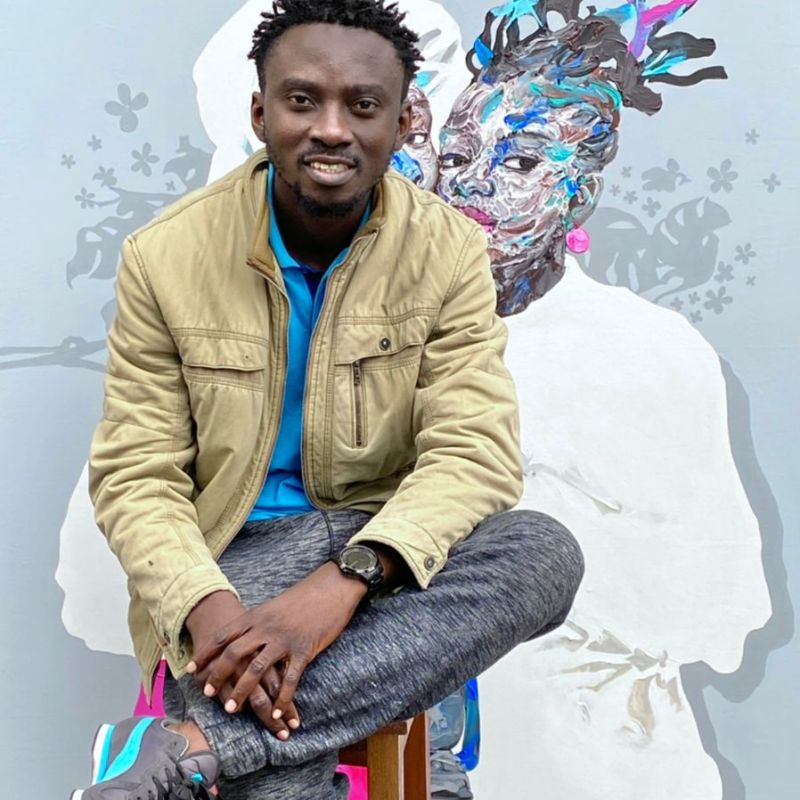(Photo credit header image: Emily King)
From her studio in Cincinnati, Ohio, Emily Moores creates both wall works & large scale installations, consisting of hand-cut and ornately layered materials. Her work investigates the playful engagement of the body as essential to understanding and experiencing spaces or objects. Inspired by Susan Best’s book, Visualizing Feeling: Affect & the Feminine Avant-garde, Emily’s interest is to explore how art relates to interpretation of feeling, emotion, & affect. Her work has been shown in various solo & group shows across the United States and she holds a BFA from The Cleveland Institute of Art and earned her MFA from The University of Cincinnati in 2014.
One month ago, Emily and I met via Zoom to talk about the intelligence of our bodies in relation to art, the benefit of sharing a studio with two kids and two dogs, and why verbalization is not always needed to create or understand a piece of art. Enjoy!

Paper, Wood & Light , 120 x 79 x 42 in
*****
Hi Emily, thanks for being here today. To start with, please introduce yourself briefly and tell us how you got into art.
My name is Emily Moores, I’m a visual artist, I make mostly installation artwork. Recently, I’ve been making mixed-media pieces and collages, using wallpaper, textures and patterns, and I love using a lot of colour and a lot of textures, and thinking about the way that our bodies interact with those materials. As for how I got into art, I would say that like a lot of artists, I loved making art when I was a kid. I was really supported by my family and it just felt like a natural thing to go to college for art. For me, it was rather: how do I do this than if I should do it. It felt like the main option in my life that was like a given.

Mixed Media, 360 x 480 x 240 in
In your statement I read: My work explores tactility, and its ability to immaterially communicate feeling. I use the playful movement of a body to increase energy, release positive endorphins and improve memory. Could you please talk a bit more about that?
I really love the book Visualizing Feeling: Affect and the Feminine Avant-garde by Susan Best, and one of the things she talks about is affect and art, connection to physical objects through a feeling. Now, affect isn’t necessarily a personal feeling, it could be the mood in the room, and it’s a form of intelligence. In the book she talks about how we walk into a room and see the minimalist work of a nail in a piece of wood and we’d say, this is aggressive, but really, it’s an inanimate object, it’s not being aggressive. But, the way it brings in the mood, everybody interprets it in a similar way, there’s a form of intelligence behind it. So, conceptual art is kind of objective, but really, this way that we’re talking about artwork is anthropomorphising it, we’re giving these attributes to inanimate objects, and instead of seeing it as a bad thing it’s just another way to think about art.
What she talks about is that how we understand our bodies in relation to art is an intelligent way to think about or interpret works of art.
It’s a way that everybody, regardless of your background or who you are, or your level of education, can come into a gallery or a museum and have an intelligent relationship to an artwork. The viewers don’t have to necessarily have all the words, but they can just think about their bodies, how their bodies move into the space, and what is the mood that they feel from a work of art. So, there is this sense of empowerment with the notion of affect that I really appreciate.
And with installation art, you know, it’s temporary, and it’s built for the space, so even if I rebuild something in another location, it’s never going to be the same. And I think in a world where we’re constantly documenting everything on social media, we have this false sense of permanence with documentation. But documentation is really only going to last as long as people who are in charge of the documented files are operating.
What I love about installation is that it really focuses on the moment. You can’t really take a picture and understand an installation. It’s something that you have to experience and you have to be there in that moment.

Paper, wood and fabric, 180 x 360 x 120 in
Could you please share your creative process with us, from an idea to a finished piece?
For installation, I would start with thinking about the mood that I want to create, recently I’ve been really focusing on creating a playful spirit or a playful mood. I’ve been doing little models, but usually the models are just to create the skeleton of the installation. I was just in Sheridan, Wyoming, to do an installation, and even though I told myself I’m really going to plan out this installation ahead of time, I ended up not totally planning it out. I got to this phase, and then how I had envisioned the space was different than how the space actually was. The skeleton of how I wanted the viewer to move through the space was the same (I have these ropes moving through the space) and where the viewer moves is the same where I was planning it, but once I got there I made some changes. I originally had planned out to paint the entire wall and then I only painted half the wall in shapes. Once I get into a space, I have an order of the materials that I want to use in my mind. First, I paint the walls, then get the big stuff up, like I had these inflatable beach balls that were one of the first things that went up, and then there were smaller detailed things that came in last.

Paper, Wood & Light , 120 x 79 x 42 in

Paper, Wood & Light, 72 x 36 x 120 in
And how do you choose your materials?
Usually I make them all at home, and then I put them together. My studio is not that big, so usually I just plan it out in my head how they’re going to look together. For the exhibition of Wyoming, it would be a 24 hour drive to get there form where I am in Ohio, so, I had to fly and that changed how I planned my material system. Some of the things I ordered from Home Depot or online, and I had them shipped there to the gallery, and I ordered the paint online, too. When ordering paint online, you can see the colour but it’s just not the same as the physical, real paint. So, with this past exhibition it was more like winging it, because shipping it to my house, and then shipping it to the gallery would have been too expensive, so it was just easier to ship it directly to the gallery.
Do you draw any sketches of your works?
I don’t know that I really draw. I mean, I make mixed media works but most of it, (I might do a little thumbnail sketch) but most of it is cutting out textures and patterns.

Paper, Fabric, Rope, Wood and Wire, 120 x 96 x 180 in
The pieces you create and how you create them is a very physical, hands-on activity & experience. Could you put into words how it makes you feel and what you treasure about it?
I feel like the physical process is part of what makes us human and also being alive in this world. Part of it is having relationships with people around us and part of it is being in relationship just to the world around us. Being aware of the physical textures is just a part of being in the moment.
In your statement one line stood out to me specifically, “The modern world is filled with constant stress for both children and adults”. Could you please comment on that and how that relates to your practice?
You know, I heard someone say a while ago that it’s as though all of those time saving devices have actually taken away a lot of time from us. So, there was more leisure time hundreds of years ago when people would head out to hunt and get all of their food and do all of the labour towards survival.
We have more time taken away through the more active devices that we have. I think play is something that has been erased for kids and for grown-ups.
A lot of kids are just over-scheduled, and they’re constantly consuming, candy, for example, like my kids at school. There’s constant activities, and just being playful isn’t something that is valued. I think that people are starting to change their mind now, but being playful isn’t something that has been valued as much in the past couple of decades, especially with raising children. Especially for grown-ups, being playful is a way to also bring in those connections. Play helps us to relax and be authentic with people that we love, for instance when we play games, whether they be board games or just goofing of.
Play is something that brings us into the moment of what is going on rather than having our mind in a million different places.

Digital Print, Sizes Vary
You share your studio with your two children and two dogs, and I believe that some artists would see that as a challenge, an obstacle even. My question is: have you also felt that way or do you actually benefit from that energetic atmosphere?
I have not felt having my kids and my dogs in the studio was an obstacle. My studio is in my attic, so it’s a little bit smaller, and sometimes I wish I had a little bit more space, but my kids have definitely influenced me in a good way.
I had a lot of anxiety about being perfect and being able to perfectly describe every aspect of my artwork. When I was pregnant with my second daughter and my oldest was about two, I was watching her just explore the world,and you know, mark-making for a two year old is really just exploration. It’s just about watching the material, and every leaf was interesting to her, every rock is something that we had to save. And my kids are still like that, they collect little everything from the ground, and that influenced the colour shift in my artwork. If you look at my artwork, it used to be all white, and that was just because I didn’t know how to talk about colour. So, as my kids have grown older, I’ve gotten more playful because it just doesn’t seem as important (to verbalize my work).
There are other ways of understanding the world rather than having to verbalize everything, and that’s okay and you can just play and and be in the moment.
So, I like the chaos and having them with me. I mean, sometimes they want to paint on everything, they want to paint my artwork and I have to explain: you have to do your own artwork. But that’s why this Christmas I’m getting them art supplies, so that they can have their own supplies and they don’t need mine.
Any advice you’d like to share with emerging artists?
Somebody asked me this question a while ago and at the time I talked about defining your own ideas of success. But recently, it’s come to my attention- and this is more of a practical advice- that LinkedIn is a good platform for artists. If you follow a gallery on Instagram, you might just be communicating with their (social media) intern or marketing team, depending on how large they are, but on LinkedIn, people present themselves along with their job, so if you want to find curators, that’s a good platform to do so, and I’ve been trying to connect with people through LinkedIn. That’s my practical advice, not a big, lofty one (laughs).

Digital Print, Sizes Vary
And what have you been working on recently?
I just finished installing last week in Sheridan Wyoming, and it was nice to go. It’s a small town, it’s only like 17 000 people, so it was a lot smaller than what I’m used to, but everybody was so nice. I think sometimes we forget how valuable people are even in places that aren’t heavily populated, so it’s been a really wonderful experience and I would just recommend applying to galleries in smaller towns.
I saw that you participated in two virtual residencies, hosted in Serbia and Bulgaria.
Yeah, it was nice to meet people online, and it’s cheaper because you don’t have to ship all your supplies and you can just meet people from all over the world. I mean, obviously, having in person residencies is really important but doing a virtual one was also really helpful. Just being able to connect and talk to other artists without having to completely abend my life.
And, last question: what are your hopes for the future?
I just want to continue to exhibit my art and continue my art career. I want to continue to apply to grants and maybe someday do like a show internationally.

Photo Credit: Emily King
*****
Get in touch
with Emily:
www.emilymoores.com
Instagram: @emilymoores_art
All Photographs courtesy of Emily Moores
Photo credits for photos of the artist: Emily King
Written, interviewed & edited by Nina Seidel
© Copyright 2023 Suboart Magazine
All rights reserved

Do you like Suboart Magazine? Subscribe to our email list to receive monthly news on opportunities, interviews & features.
Discover more emerging artists












